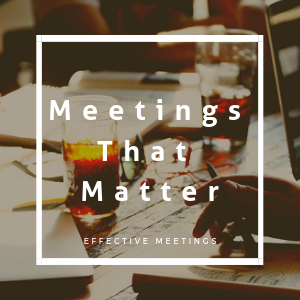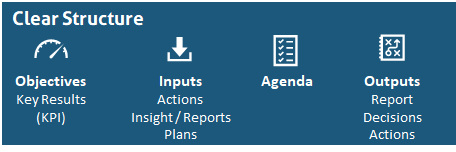Meetings can feel like the bane of our life. “I have too many meetings, to do my job”. They can cause burn out, or the team are always in meetings and not doing their work. Just restructuring your diary, reorganising the meetings and making them more effective can clear your diary, and make the whole team deliver more. Here’s 5 tips to take yourself on the way. 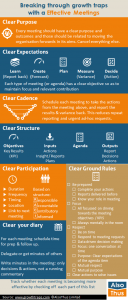 A few years back I was doing a sales presentation to the Ministry of Defence. It was a first, exploratory meeting, and there were 3 of us, and we were expecting 2-3 people from the MOD. We arrived and there were about 12 people, several of which had travelled across the country for the meeting. I was in awe, just thinking about the effort people had made to meet us, and the cost of 12 senior people in one meeting. When we came to the end of the presentation, the host said that this was really important and quite urgent, so let’s get a follow up in the diary. And they proposed meeting in 3 months time. that’s not urgent in my eyes! Did we need everyone? – No. Could we have cleared diaries? – yes. Did other work get missed by being at this meeting? – Yes. So if you’ve ever been in a place where your diary is filled, and you end up working too late, or the meetings are in effective, here’s 5 tips to break that growth trap:
A few years back I was doing a sales presentation to the Ministry of Defence. It was a first, exploratory meeting, and there were 3 of us, and we were expecting 2-3 people from the MOD. We arrived and there were about 12 people, several of which had travelled across the country for the meeting. I was in awe, just thinking about the effort people had made to meet us, and the cost of 12 senior people in one meeting. When we came to the end of the presentation, the host said that this was really important and quite urgent, so let’s get a follow up in the diary. And they proposed meeting in 3 months time. that’s not urgent in my eyes! Did we need everyone? – No. Could we have cleared diaries? – yes. Did other work get missed by being at this meeting? – Yes. So if you’ve ever been in a place where your diary is filled, and you end up working too late, or the meetings are in effective, here’s 5 tips to break that growth trap:
1. Clear Purpose
Every meeting should have a clear purpose and outcomes and those should be related to moving the organisation forwards in its aims. Cancel everything else. When I send a meeting invite, I usually add the purpose and expected outcome of the meeting, and often include the background too (or what it follows from). With many clients and meeting booked months in advance, it gives me a reminder of what it’s about, and the audience know why they’re there. Action: Ensure you have a purpose and output in all meeting requests
2 Clear Expectations:
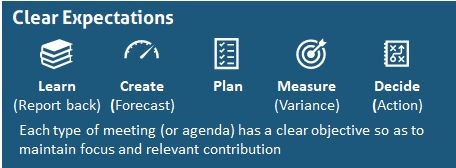 Often it’s not clear what a meeting is for. It might be the regular ‘catch-up’ meeting or scheduled in the diary, or you get requested to join a meeting for your input, or you should be aware. There are 5 types of meeting and when you look at your diary, it’s worth noting what each is for (and if it fulfils the purpose)
Often it’s not clear what a meeting is for. It might be the regular ‘catch-up’ meeting or scheduled in the diary, or you get requested to join a meeting for your input, or you should be aware. There are 5 types of meeting and when you look at your diary, it’s worth noting what each is for (and if it fulfils the purpose)
- A Learning meeting – interview, visioning meeting, retrospective
- This will have an intro, setting the scene for information capture, set of questions or activities to capture information, summary, close
- A Creative meeting – designing, Forcastingplanning, shaping.
- This will have an intro, a design activity, a close and next steps
- A Planning meeting – budget planning , headcount, sales planning
- This is taking a forecast, KPI or objective and working out how to achieve it, with whom and by when and what the dependencies are.
- A Measurement (or tracking) meeting – project status, financial review, sales status
- This will have an intro, review of actions so far, a presentation of status, update on risks, and list of actions & decision arising
- A Decision meeting – design review, sales review, action plan
- This will have an intro, a presentation of the decision requested, feedback, decision and action.
- The last type of meeting is a one to one – A Coaching meeting – project review, one and one
- This will include a status of what’s been done, what’s to do, issues arising and areas for QA, input, or coaching
To be effective you need a selection of these meetings in your month – to do the daily task, and grow yourself , your team or improve the daily task. Action: have a look at your week and do you have the right balance of meetings? Are they obvious on what type of meeting it is? Do you ever have people going into creative mode when the meeting is actually to report or decide?
3 Clear Cadence with the Organisation
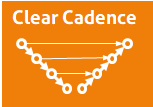 You may or may not have the ability to influence this – but you can make sure the meeting you attend fit in the right place. You’ll know when your meetings don’t match the cadence, when you get urgent requests to do a presentation/spreadsheet etc for a meeting days or weeks before your planned meeting, or you end up having loads of ad-hoc one to one meetings, or you have to do reports multiple times for each audience. Action: Grab the calendars for the organisation (e.g. board meetings), directors meetings, down to your area, and understand what inputs the next meeting in seniority to yours needs. Place your meetings before that, and design the output of your meeting to match the input of theirs.
You may or may not have the ability to influence this – but you can make sure the meeting you attend fit in the right place. You’ll know when your meetings don’t match the cadence, when you get urgent requests to do a presentation/spreadsheet etc for a meeting days or weeks before your planned meeting, or you end up having loads of ad-hoc one to one meetings, or you have to do reports multiple times for each audience. Action: Grab the calendars for the organisation (e.g. board meetings), directors meetings, down to your area, and understand what inputs the next meeting in seniority to yours needs. Place your meetings before that, and design the output of your meeting to match the input of theirs.
Result: You only do work once, and what you produce is immediately used by the next team meeting
4 Clear Structure
Google uses the idea of Objectives and Key Results. So any meeting is there to drive us toward our key results – which could be customer satisfaction, revenue, patients seen etc. Any meeting has a 4 components:
- Objectives – what’s the purpose of the meeting taken from the business objectives and KPIS used for the meeting
- Input – this is the data to make decisions. This includes the actions from the last meeting, reports on achieving the KPIs or Objectives or presentations.
- Agenda – this makes it clear on the expectations of each topic of conversations (i.e. are we learning, creating, planning , testing variance, or deciding)
- Outputs – this is the decisions and actions from the meeting, plus insight or reports that go to the next level of meeting above.
The key element of success is the Measurement, and it’s a cultural shift to insight / data driven decision making. We have a goal, and use measures to tell us if we are on track. In an agile world, the measure can come from testing and idea or a minimum viable product. The learning is it worked or it didn’t – and that’s okay. However without insight and data we are just making decisions on a whim.
Action: Ensure the first slide of each meeting or the agenda sheet, covers the meeting purpose, objectives, inputs, outputs, and agenda. This helps keep the group focused and clear on why there are there.
5 Clear Participation
When you know what you’re going to achieve, how it fits into the overall organisation’s calendar (and key milestones), plus the inputs that you need, it’ll be much clearer who you need at the meeting. Building a RACI can help determine what roles those people are. Keep the ‘Informed’ people to a minimum otherwise they should be ‘Contributors’. Informed people will be at a ‘Learn’ type meeting or just get the reports and outputs of the meeting.
Action: Prune attendees of meeting to the bare minimum and manage the issues when people feel upset in not being invited (releasing their time, giving them input elsewhere, or showing the right level of meeting for them).
6 Clear Ground Rules
You will need to select the ground rules that work for you. Here are a selection:
- Be prepared
- Complete your actions
- Reports & presentations are delivered before (and take into account the participants preferences for pictures, numbers, words and stories/ emotions)
- Know your role in meeting
- The right seniority and authority is in the room to make decisions
- Focus
- Be focused on driving towards the meeting objectives / KPIS
- Always mentally in the room
- Respect
- Be on time
- Respond to meeting requests
- Data driven decision making
- Focus: one conversation at time
- Purpose: Clear expectations of the agenda item
- Ensure Mutual respect
- Ensure Mutual purpose
- Give psychological safety
- Clear actions to solve issues
- People understand their different personality types, and the way they receive and process information
- Follow up
- Clear actions for each issue or variance in the report
Action: For your regular meetings introduce and agree groundrules and refer back to them
7 Clear Your diary
Now you should have a clear idea of what meeting you should be at. Look at your months diary, and take every thing out. Then place back each meeting AND add time for preparation and follow up. A good rule of thumb is for each hour of meeting, add an hour of prep and an hour of follow up. This is the stuff your rushed, neglected to do, or did late at night before. By giving yourself this time and placing it in the diary, YOU will be more effective because you’ll get your actions done.
Action: Delegate or cut out meetings you don’t need to be at. Cut out ad-hoc meetings and shift them into the normal meeting cadence. “That’s a great idea, let’s add that to the agenda for [xyz meeting].
8 Clearly changing behaviours
It takes time to change behaviours so track how you’re doing on meetings. Ask a colleague to monitor and coach you on your meetings. If you are a team leader then allocate someone (internally or externally) to monitor the effectiveness improvements over the next 1-3 months. When I was working at one consulting firm the focus on effective meeting was a key element of turning strategy and plans into reality. Or put it another way, without changing the way we run meetings (and mindset) , we’re not likely to get the results we are looking for. The infographic below summarises the 8 points – so you can use this as a checklist that each element of the meeting has been set up 
